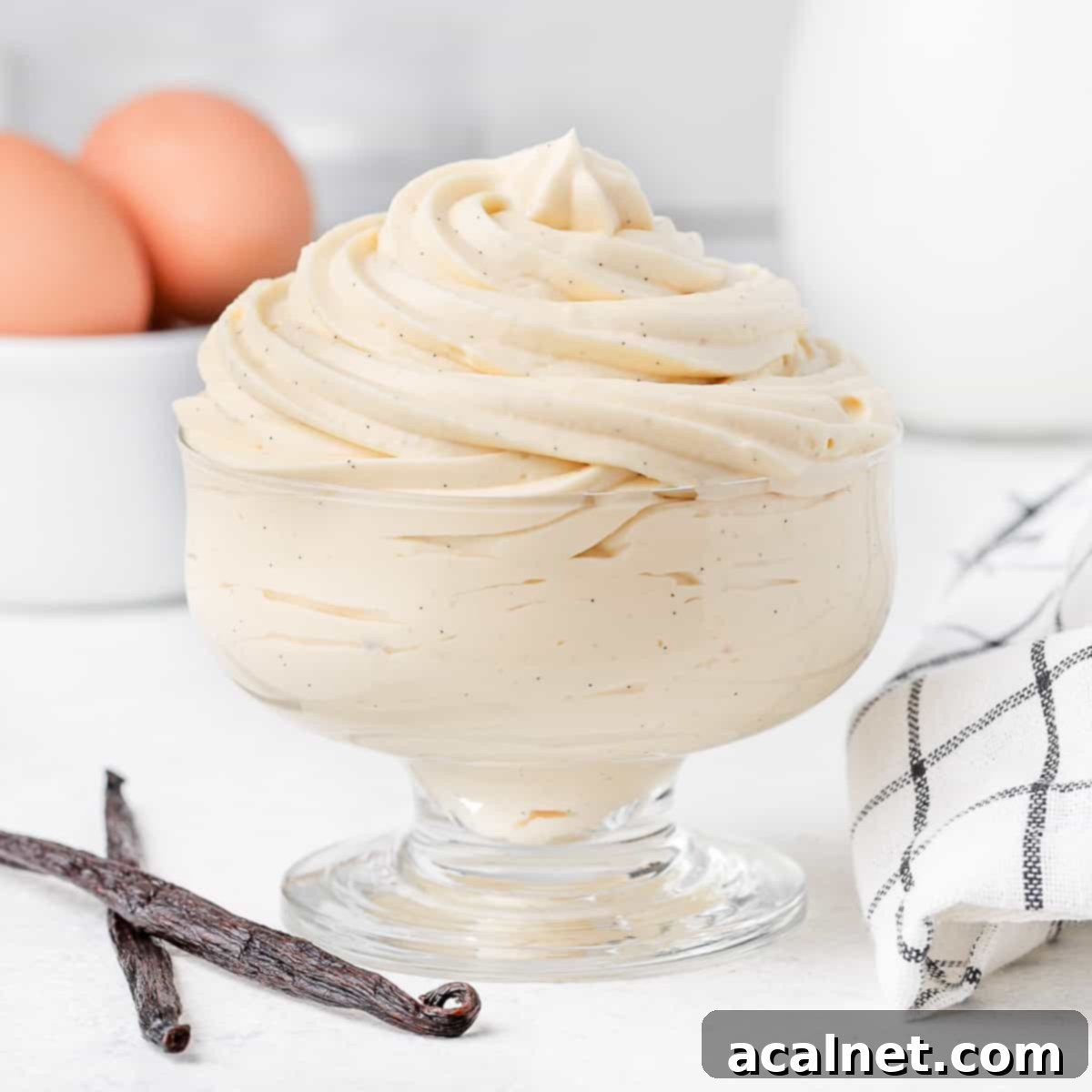Ultimate Vanilla Bavarian Cream (Crème Bavaroise) Recipe: A Guide to Making This Light & Creamy French Dessert
Discover the art of making the perfect **Vanilla Bavarian Cream**, known in French as **Crème Bavaroise**. This exquisite dessert or versatile cream filling is renowned for its incredibly light texture and rich, aromatic vanilla flavor. It’s a classic French pastry staple, masterfully combining a velvety pouring custard (Crème Anglaise), just the right amount of gelatin for a delicate set, and airy whipped cream, resulting in a truly unforgettable treat.
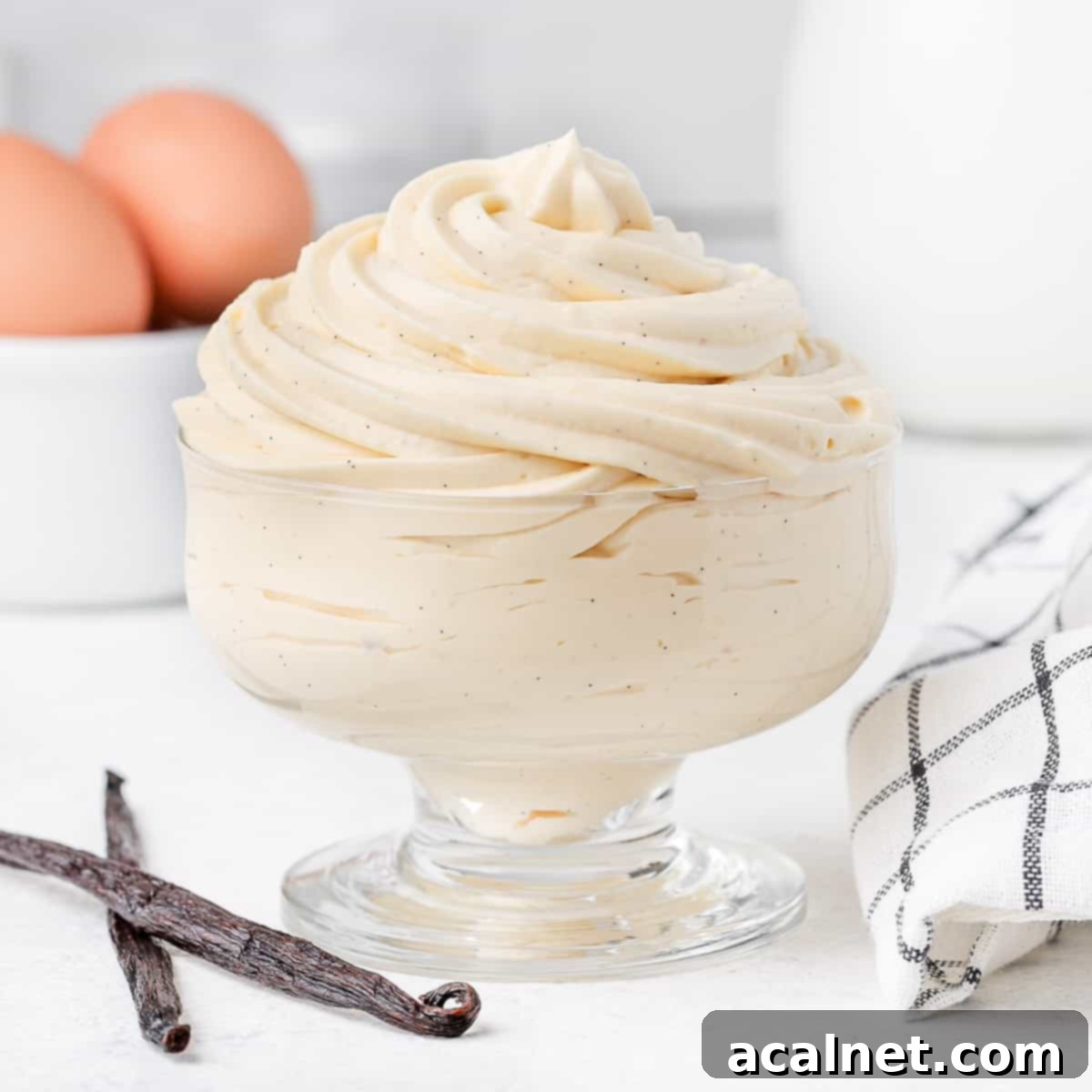
[feast_advanced_jump_to]
Why You’ll Love This Bavarian Cream Recipe
This Bavarian Cream recipe stands out for its exquisite balance of richness and lightness, making it an absolute delight for any dessert enthusiast. Crafted with just six essential ingredients, it transforms into a delicate, ethereal cream that’s incredibly versatile for a myriad of culinary applications. Unlike heavier creams, its unique composition delivers a melt-in-your-mouth experience, perfect for those seeking a sophisticated yet approachable dessert.
It’s notably lighter than similar preparations like the rich Diplomat Cream or the buttery Mousseline Cream, while offering a creamier consistency than the classic Pastry Cream. A well-made Crème Bavaroise is simply divine served on its own in elegant glasses, or it can elevate a wide range of pastries and desserts. Imagine it nestling inside delicate Choux à la Crème, forming the luscious layers of a Strawberry Charlotte Cake, enhancing Bavarian Cream Donuts, or even becoming the star of a grand Chocolate Bavarian Cake. Its adaptability ensures it will quickly become a cherished recipe in your baking repertoire.
What is Crème Bavaroise (Bavarian Cream)?
Crème Bavaroise, universally known as **Bavarian Cream**, is a revered traditional French pastry recipe with a fascinating history. It elegantly marries three core components: a rich Crème Anglaise (a smooth pouring custard), a setting agent like gelatin for structure, and fluffy whipped cream to achieve its signature light and airy texture. This delightful creation is attributed to the celebrated French chef Marie Antoine Carême, who developed it in the 19th century, drawing inspiration from Bavarian desserts.
Its versatility is one of its most defining characteristics. Crème Bavaroise can be presented as a standalone dessert, served chilled in individual cups much like a mousse, or set beautifully in decorative molds, similar to a panna cotta, creating an impressive presentation. Beyond a simple dessert, it functions as an exceptional cream filling for an extensive array of pastries, tarts, and cakes, adding a touch of sophisticated creaminess that enhances any sweet creation. Its delicate balance of flavor and texture makes it a perennial favorite in fine patisseries worldwide.
Essential Ingredients for Bavarian Cream
Crafting the perfect Bavarian Cream starts with selecting quality ingredients. Each component plays a vital role in achieving the desired flavor and ethereal texture. Here’s a detailed look at what you’ll need:
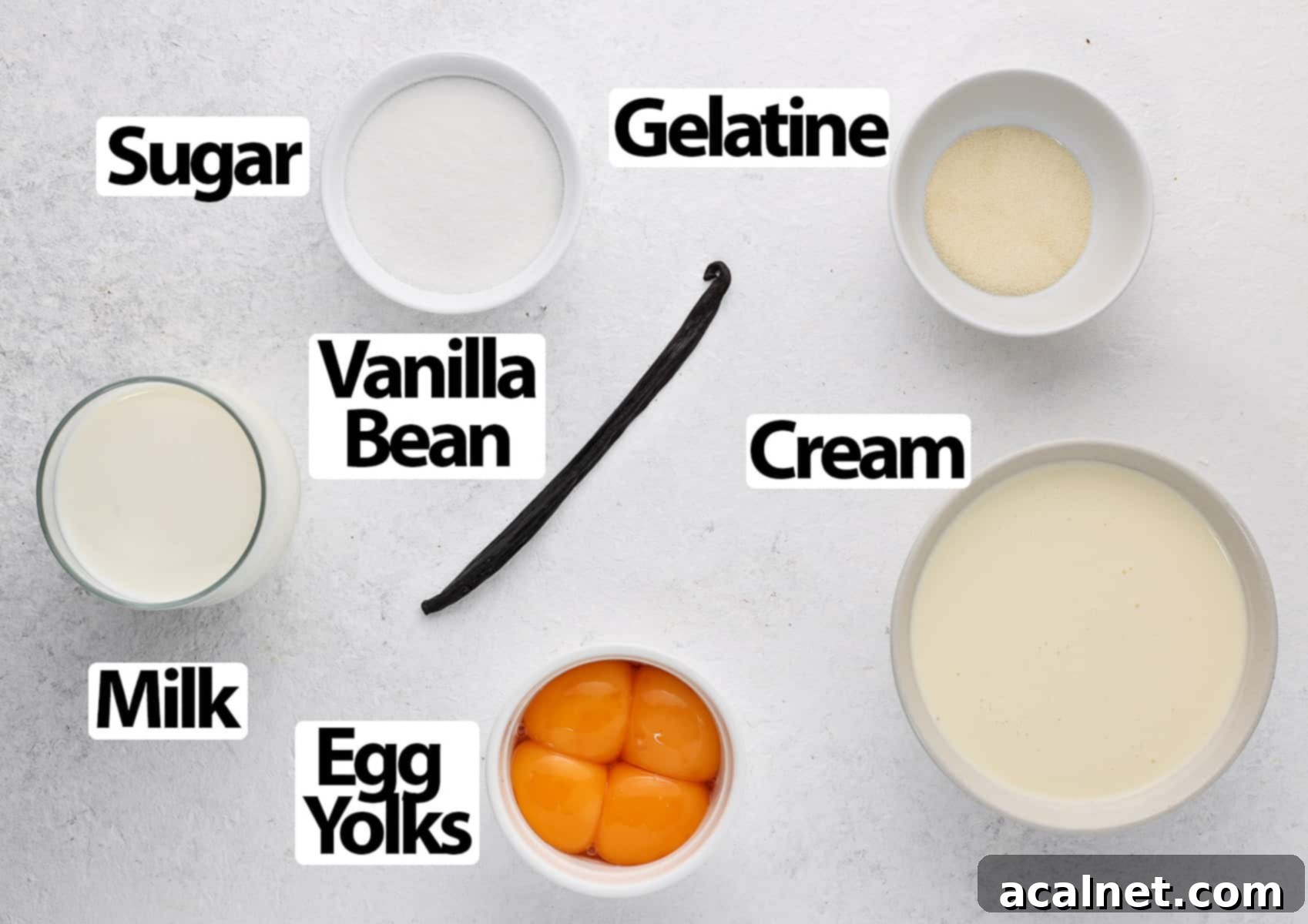
Scroll down to the recipe card below for all precise quantities.
Here’s what goes into a delightful Bavarian Cream filling:
- Milk: For the most luxurious flavor and creamy texture, opt for Full Cream or Whole Milk. Its higher fat content contributes significantly to the richness. If dietary restrictions require it, a plant-based or dairy-free milk can be used, though the final texture might be slightly different.
- Vanilla: The essence of classic Bavarian Cream. A fresh Vanilla Bean provides the most authentic and robust flavor, with beautiful specks throughout the cream. As an alternative, high-quality Vanilla Paste is an excellent substitute. While vanilla extract will work, it will yield a less intense and nuanced vanilla taste.
- Eggs: Only the Egg Yolks are used in this recipe, acting as a natural thickener and enriching agent for the custard base. Ensure they are at room temperature to prevent curdling when combined with warm milk. Don’t discard the egg whites; they can be used for other delicious recipes like Financier Cakes or meringues.
- Gelatin: This is crucial for setting the Bavarian Cream. I typically use Gelatin Powder, which needs to be “bloomed” by dissolving it in a small amount of cold water first. Gelatin sheets or leaves can also be used, following the manufacturer’s instructions for hydration. The gelatin provides the stability needed for the cream to hold its shape.
- Caster Sugar: A fine-grain sugar that dissolves easily into the egg yolks and milk, ensuring a smooth, sweet custard without a gritty texture.
- Cream: Heavy or Thickened Cream is essential. Look for cream with a minimum fat content of 30% (ideally 35% or higher). This high-fat content is critical for the cream to whip up properly and achieve stiff peaks, which are necessary for the light and airy consistency of the Bavarian Cream. Creams with lower fat percentages will simply not whip effectively.
Exciting Flavour Variations for Your Bavarian Cream
While classic vanilla Bavarian Cream is a timeless delight, its base is incredibly adaptable, inviting you to experiment with a myriad of exciting flavors. Here are a few popular variations to inspire your culinary creativity:
- Chocolate: Transform your vanilla Bavarian Cream into a decadent chocolate version. You can achieve this by adding some high-quality cocoa powder directly to the milk while heating it, allowing the chocolate flavor to infuse deeply. Alternatively, melt finely chopped chocolate into the warm Crème Anglaise base before adding the gelatin. Keep in mind that for a truly rich chocolate flavor, the ratios of other ingredients might need slight adjustments.
- Fruit: Infuse your cream with the vibrant taste of fresh fruits! Replace a portion (or even all) of the milk with a smooth fruit puree or fruit juice. This is a fantastic way to create seasonal Bavaroise desserts, much like the bright and zesty Lemon Meringue Cake example. Popular choices include raspberry, strawberry, mango, or passion fruit puree.
- Coffee: For coffee lovers, a robust coffee-flavored Bavarian Cream is irresistible. Simply add instant coffee powder or a shot of strong espresso to the milk before heating it up. The warmth helps dissolve the coffee and allows its aroma to blend seamlessly with the dairy, creating a sophisticated dessert.
- Praline Paste: Introduce a delightful nutty and caramelized dimension with the addition of Hazelnut Praline Paste. Stirring this luxurious paste into the warm custard base adds an incredible depth of flavor and a wonderfully smooth texture, perfect for an elegant dessert or filling.
- Liqueur: For an adult twist, a splash of your favorite liqueur like Grand Marnier, Kirsch, or a coffee liqueur can add an extra layer of complexity and aroma. Add it to the cooled custard before folding in the whipped cream.
How to Make Vanilla Bavarian Cream: A Step-by-Step Guide
Creating this elegant French cream is a rewarding process. Follow these detailed steps to achieve a perfectly smooth, light, and flavorful Bavarian Cream.
Part 1: Crafting the Velvety Crème Anglaise Base
The foundation of any great Bavarian Cream is a meticulously prepared Crème Anglaise, a pouring custard that is rich and smooth. This process is similar to making Pastry Cream, but without the addition of any starch, allowing it to remain lighter.
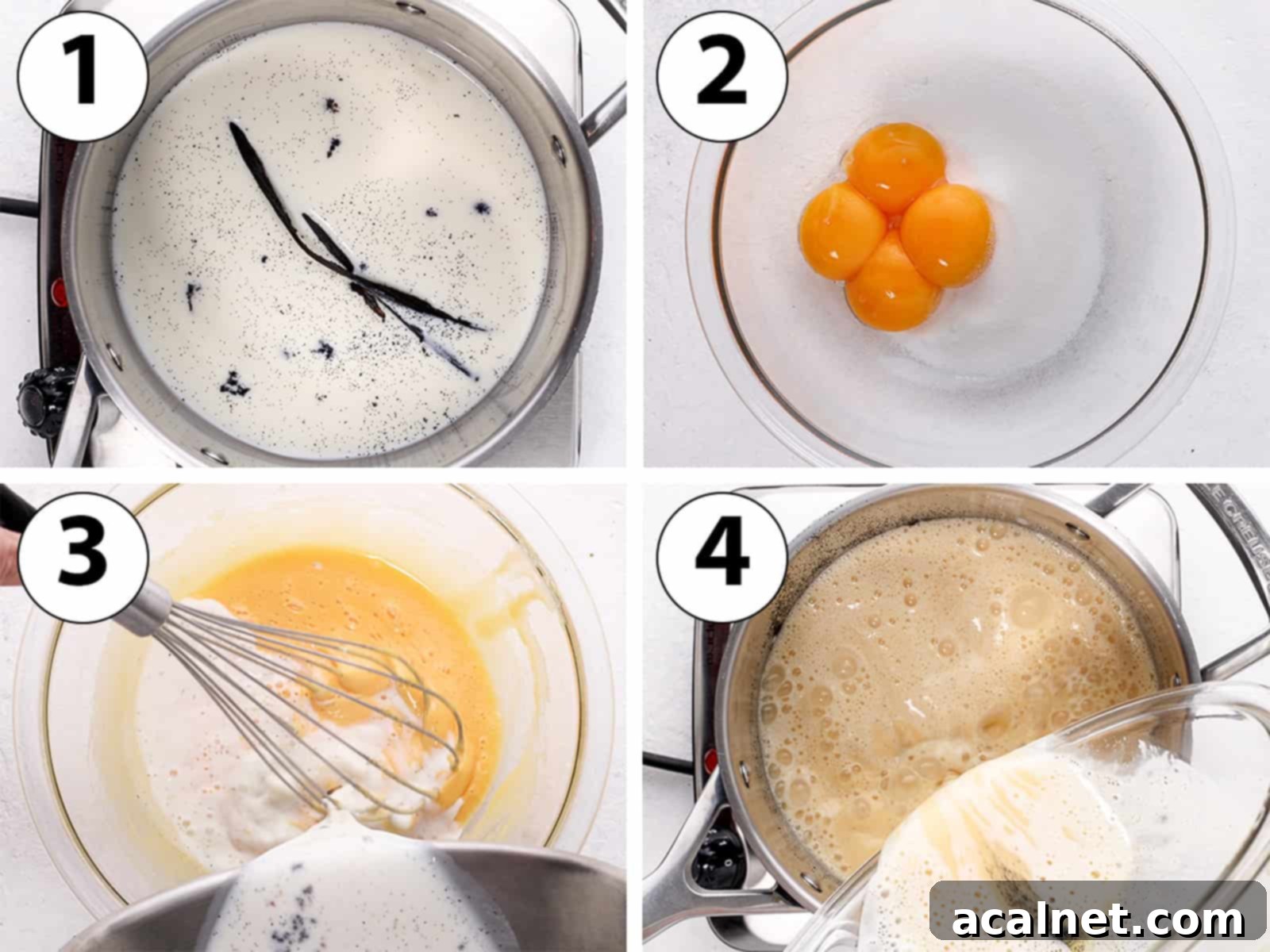
- Photo 1: Begin by pouring the Milk into a medium-sized saucepan. Take a fresh Vanilla Bean, carefully slice it in half lengthwise, and scrape out the aromatic seeds. Add both the seeds and the empty pod into the milk. Heat the milk over low to medium-low heat, bringing it gently to a simmer. Once simmering, remove the saucepan from the heat, cover it, and allow the vanilla to infuse for 10 to 20 minutes. This step is crucial for developing a deep vanilla flavor.
- Photo 2: While the milk is infusing, combine the egg yolks and caster sugar in a large, heat-proof bowl. Whisk vigorously until the mixture is pale yellow and creamy. The sugar helps to break down the egg yolks, creating a smoother consistency.
- Photo 3: This is the tempering step, essential to prevent the eggs from scrambling. Slowly and gradually pour about one-third of the warm, infused milk into the egg yolk mixture, whisking continuously and quickly. This gentle introduction of heat raises the temperature of the egg yolks without cooking them too fast.
- Photo 4: Once the egg yolks are tempered, transfer the entire mixture back into the saucepan with the remaining milk. Make sure to scrape all the precious vanilla specks from the bowl back into the pan. Return the saucepan to low heat, stirring constantly with a whisk or a wooden spoon. Continue cooking gently, without allowing the mixture to boil, until it thickens sufficiently.
Part 2: Achieving the Signature Lightness by Folding in Whipped Cream
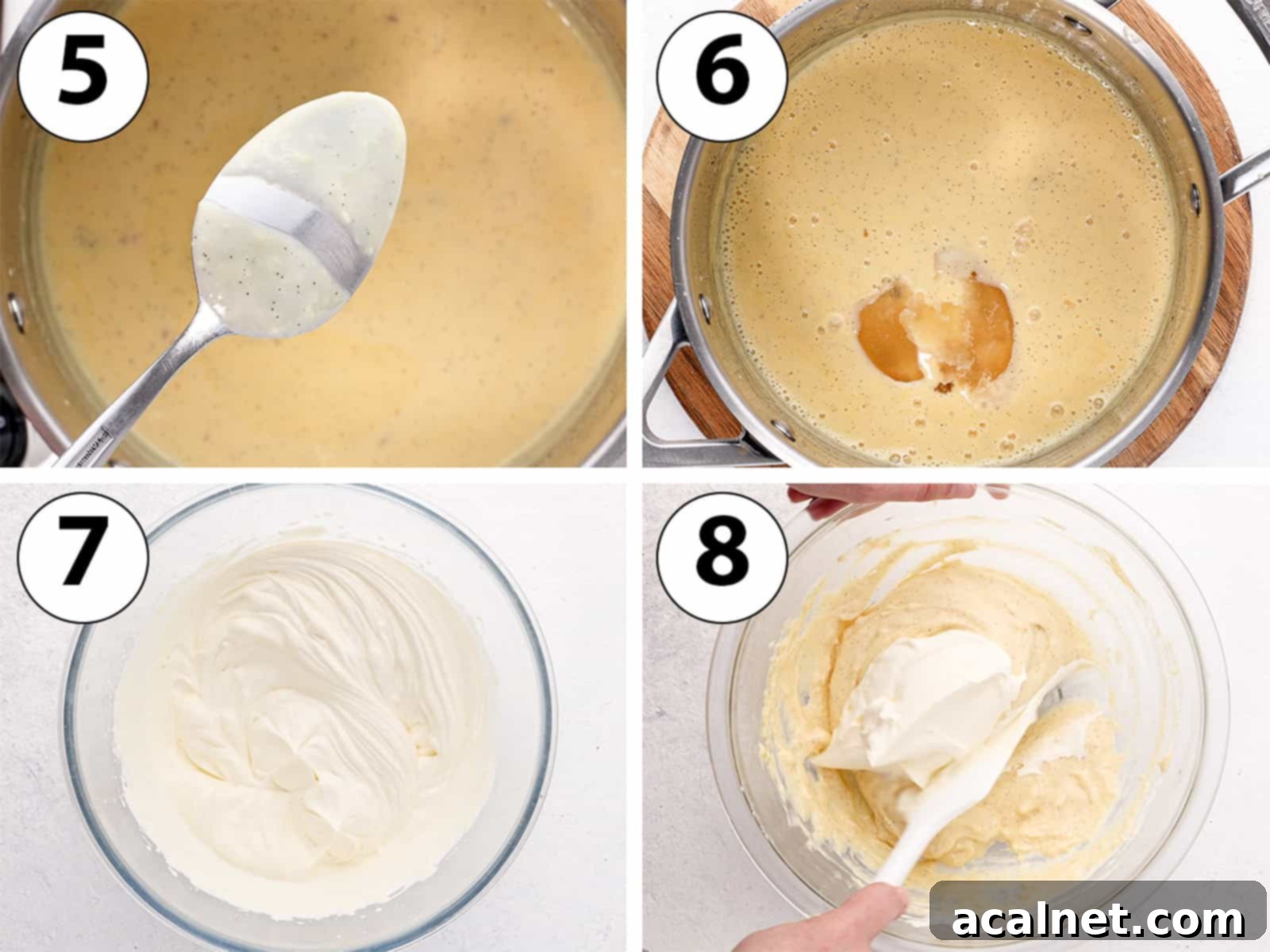
- Photo 5: Continue to cook the custard over low heat for approximately 5 to 10 minutes, stirring constantly. This ensures even cooking and prevents the custard from sticking or burning at the bottom. The key is to avoid boiling, as this will curdle the eggs, leading to a grainy texture.
To determine if your Crème Anglaise has reached the perfect consistency, you can use a few methods: either a thermometer (it’s ready when it reaches 82 degrees Celsius or 180 degrees Fahrenheit) or the classic “nappe” test. Dip the back of a spoon into the custard; it should coat the spoon evenly. If you draw a line through the liquid with your finger and tip the spoon down, the line should remain clear, indicating it’s properly thickened.
- Photo 6: In a small bowl, sprinkle the Gelatin Powder over the cold Water. Allow it to “bloom” for about 5 minutes until it forms a thick paste. Once bloomed, add this gelatin mixture directly into the warm custard. Whisk vigorously until the gelatin is completely dissolved and no lumps remain. This step is crucial for the Bavarian cream to set correctly.
- Transfer the warm custard into a clean, large bowl or a shallow dish. Cover the surface directly with plastic wrap to prevent a skin from forming. Place it in the fridge to cool down for approximately 30 minutes to 1 hour, or until it reaches room temperature and no longer feels warm to the touch. It’s important that the custard isn’t hot when you combine it with the whipped cream. If the custard has started to set too much with the gelatine, vigorously whisk it to loosen it before adding the whipped cream. If it has completely solidified, you can try to blend it on very low speed with an immersion blender to smooth it out.
- Photo 7: While the custard cools, pour the cold Heavy or Thickened Cream into a clean mixing bowl or the bowl of a stand mixer fitted with a whisk attachment. Whip the cream until it forms stiff peaks. Be careful not to over-whip, which can turn it grainy.
- Photo 8: Once the custard is at room temperature and the cream is whipped, it’s time to combine them. Slowly and gently fold the whipped cream into the custard in 3 or 4 additions. Use a spatula and a gentle lifting motion to incorporate the cream, preserving as much air as possible to maintain the light, airy texture of the Bavarian Cream.
Now your Vanilla Bavarian Cream is ready for use!
- To serve as a delightful dessert: Directly pour the finished cream into individual serving cups or elegant silicone molds. Refrigerate for at least 2 hours, or until fully set. Serve chilled, perhaps garnished with a fresh fruit compote or vibrant coulis.
- To use as a versatile filling for pastries: For items like Cream Puffs or a tart filling, the Bavarian cream can often be used immediately. If stored in the fridge beforehand, gently loosen it with a spatula or whisk before piping or spreading.
- For piping or as a sturdy cake filling: If the cream needs to hold a defined shape, such as when piping decorative elements or filling a layered cake, place it in the fridge for about 2 hours to allow it to firm up properly before working with it.
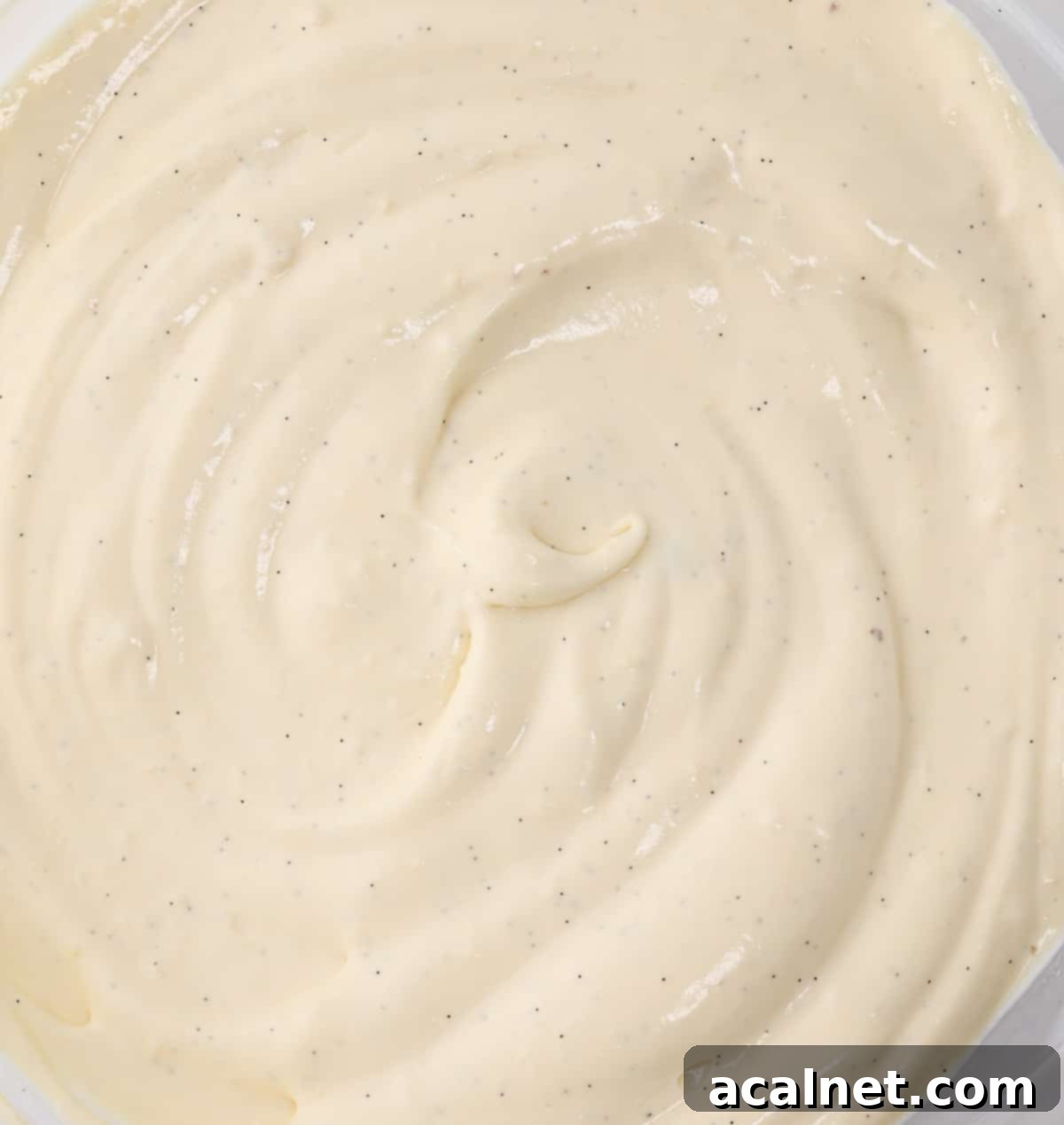
Frequently Asked Questions about Bavarian Cream
While both are foundational French creams, their compositions and textures differ significantly. Bavarian Cream, or Crème Bavaroise, is built upon a delicate Crème Anglaise base (made from milk, vanilla, egg yolks, and sugar), which is then stabilized with gelatin and lightened by folding in whipped cream. This results in a much airier, less dense, and more stable cream. Pastry Cream, or Crème Pâtissière, is similar to Crème Anglaise but is thickened primarily on the stove with a starch, typically cornstarch (or sometimes flour). It is a richer, denser cream and, without additional stabilizers, is not as firm or stable as a Bavaroise.
The classic Bavarian Cream, especially this vanilla version, offers a wonderfully rich flavor profile derived from the vanilla-infused custard, but with a surprising lightness. The addition of whipped cream transforms the texture into something ethereal, creamy, and smooth, almost like a delicate mousse. It’s sweet, aromatic, and incredibly satisfying without being overly heavy, making it a perfectly balanced dessert or filling.
The necessity of gelatin in Bavarian Cream largely depends on its intended use. If you plan to serve the cream as a standalone dessert, set in a mold, pipe it for decoration, or use it as a filling for layered cakes (like this elegant Strawberry Charlotte Cake), gelatin is absolutely crucial. It provides the necessary stability and structure for the cream to hold its shape. However, if you are using it purely as a softer cream filling inside pastries that provide their own structure (for example, as a filling for Choux au Craquelin), where a perfectly firm set isn’t paramount, you could technically omit the gelatin. Be aware that the texture will be much softer and more akin to a thick mousse.
Several factors contribute to a perfectly set Bavarian Cream. First, ensure your gelatin is properly bloomed in cold water and fully dissolved into the warm custard. Second, the custard must be cooled to room temperature (not warm, not overly cold and set) before gently folding in the whipped cream. If the custard is too warm, it will melt the whipped cream; if it’s too cold, the gelatin might set too firmly, making it difficult to incorporate the cream smoothly. Finally, allow ample chilling time – at least 2-3 hours, or preferably overnight, in the refrigerator for optimal setting.
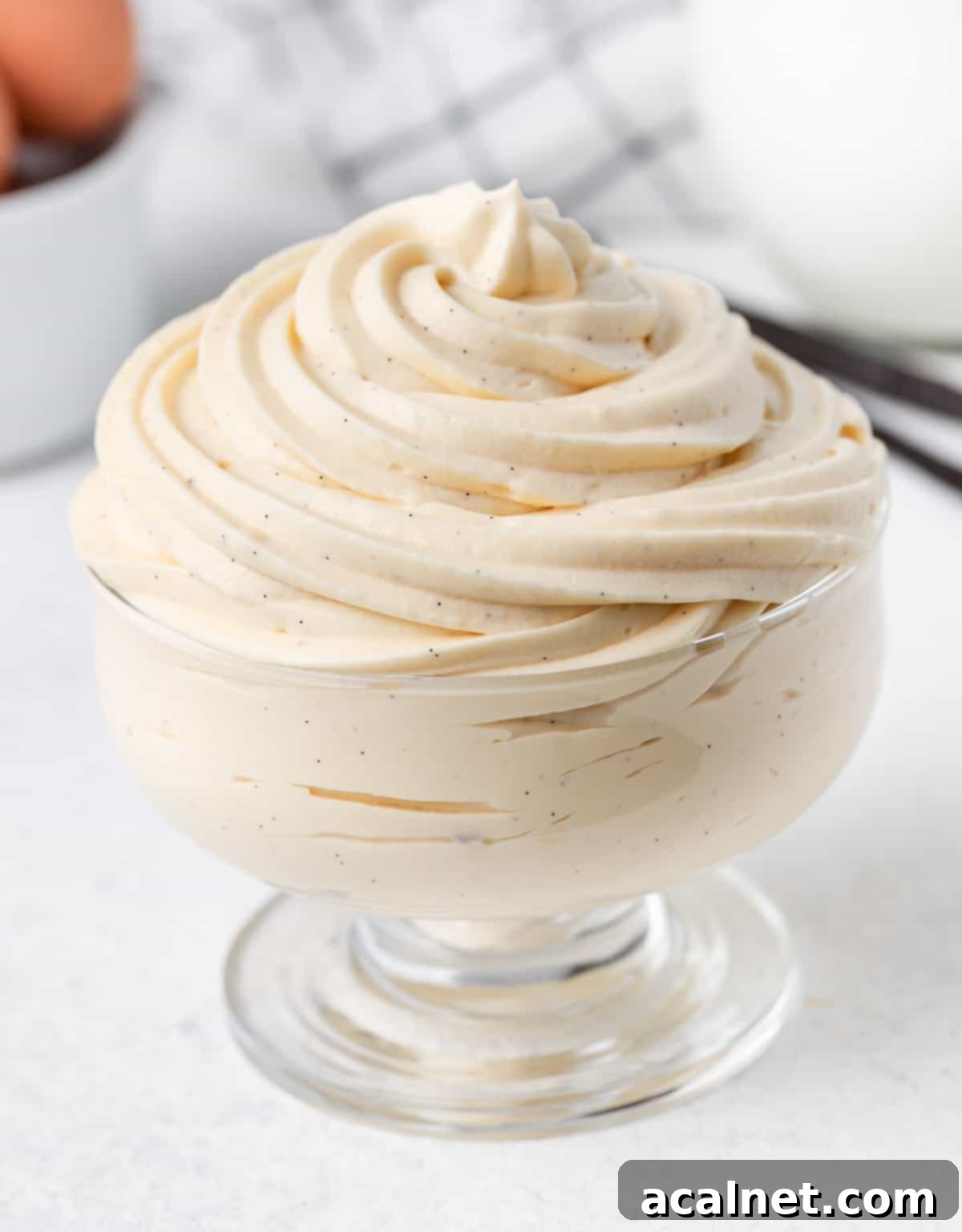
Tips & Troubleshooting for Perfect Bavarian Cream
Achieving a silky-smooth, perfectly set Bavarian Cream is within reach with these helpful tips and solutions to common issues:
- The custard base is grainy or lumpy: This often occurs if the custard was heated too quickly or at too high a temperature, causing the egg yolks to curdle. To remedy this, immediately pour the custard through a fine-mesh sieve to catch any large lumps. As a last resort, if lumps persist, you can try using an immersion blender on a very low speed to smooth out the custard, but be careful not to incorporate too much air. Always cook Crème Anglaise over gentle heat, stirring constantly.
- The custard has completely set in the fridge before folding in whipped cream: Ideally, you want the custard to be at room temperature, but still fluid, before combining it with the whipped cream. If the gelatin has caused it to set too much, vigorously whisk the custard by hand to loosen it and break up any soft lumps. If it has completely solidified into a firm jelly, it can be challenging to rescue, but a low-speed immersion blender might help to smooth it out into a workable consistency. Prevention is key here: monitor cooling time carefully.
- The Bavarian Cream is very soft and won’t hold its shape: This issue can stem from several factors: insufficient chilling time, improperly dissolved gelatin, or deflated whipped cream during the folding process.
- Chilling: Ensure it gets at least 2-3 hours (preferably overnight) in the fridge to set properly.
- Gelatin: Double-check that the gelatin powder fully dissolved in the warm custard. Undissolved gelatin won’t provide the necessary setting power.
- Whipped Cream: Make sure your heavy cream is whipped to stiff peaks before folding, and fold it in very gently to retain its volume and air. Overmixing at this stage can deflate the cream and lead to a softer final product.
Depending on how firm you need the cream to be (e.g., for intricate piping or a very sturdy cake filling), you might consider slightly increasing the quantity of gelatin or ensuring your whipped cream is very firm before folding.
- Vanilla specks are not evenly distributed: If using a vanilla bean, ensure you scrape all the seeds into the milk. After infusing, when you pour the milk into the egg yolk mixture and then back into the saucepan, make sure to scrape all vanilla residue from the bowl and sides of the pan. Stirring consistently during the cooking process will also help distribute the seeds.
Creative Ways to Use Your Delicious Bavarois Cream
Bavarian Cream, with its silky texture and delightful flavor, offers incredible versatility in the kitchen. Here are various ways to incorporate this exquisite cream into your desserts:
- As a Standalone Elegant Dessert: Serve the cream on its own, either beautifully set in individual serving cups for a simple yet sophisticated presentation, or molded into decorative silicone shapes for a more impressive touch. Enhance its appeal with fresh fruit toppings or complementary sauces.
- Pair with Fruit Compotes and Coulis: Elevate the flavor of your Bavarian Cream by serving it alongside vibrant fruit accompaniments. Imagine the delightful contrast with a sweet and tart Blueberry Compote, the exotic zing of Passion Fruit Curd, the fresh brightness of an Easy Raspberry Coulis, the unique tang of Stewed Rhubarb, or the tropical sweetness of an Easy Mango Coulis.
- As a Luxurious Filling for Pastries: Bavarian Cream makes an exceptional filling, adding richness and a light texture to baked goods.
- Fill classic Choux à la Crème (French Cream Puffs) for a delightful surprise.
- It’s perfect as the creamy base for Mini Fruit Tarts, offering a lighter alternative to traditional pastry cream.
- Transform simple Brioche Donuts into indulgent Bavarian Cream Donuts by piping it generously inside.
- Use it in other choux-based pastries like éclairs for a lighter twist.
- A Versatile Cake Filling and Entremet Component: Bavarian Cream is a fantastic choice for layering cakes and creating intricate entremets.
- It adds a tender, creamy layer to a light Strawberry Charlotte Cake.
- Incorporate it into a refreshing Lemon Meringue Cake for a balanced sweet and tart profile.
- It’s a key component for creating rich yet light Chocolate Bavarian Cakes, offering a beautiful contrast of textures.
- Use it as a delicate, stabilizing filling for mousse cakes or other layered desserts that require a light yet firm cream.
Storing & Freezing Your Bavarian Cream
Proper storage is key to maintaining the exquisite taste and texture of your Bavarian Cream. The cream should be stored in the refrigerator in an airtight container or a bowl/jar, always covered with plastic wrap directly touching its surface. This prevents a skin from forming and keeps it fresh. When stored correctly, it will last for up to three days. Due to its delicate emulsion and gelatin content, I do not recommend freezing Bavarian cream, as it tends to separate and lose its smooth texture upon thawing.
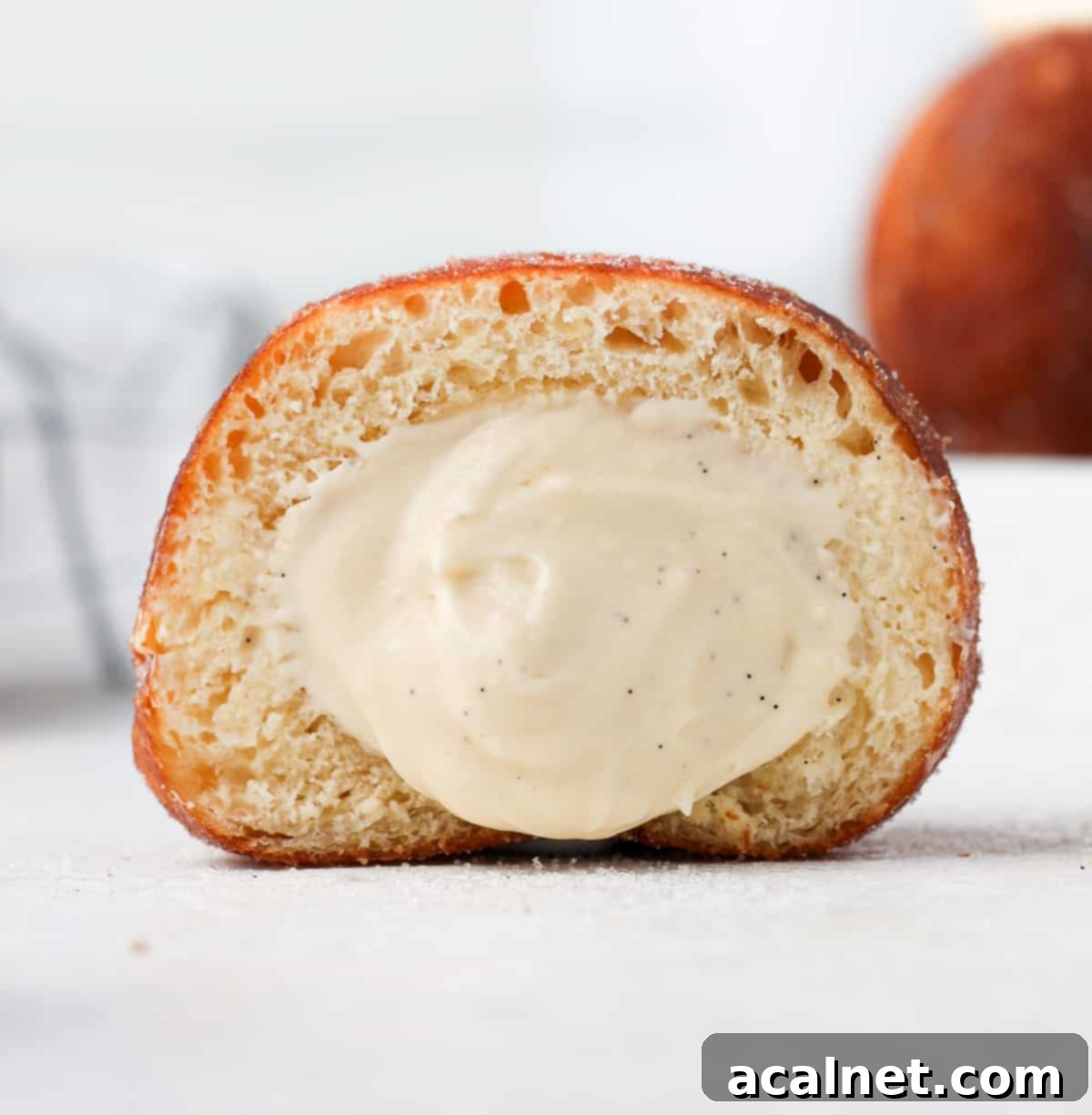
Explore More Delicious Cream Recipes
If you’ve enjoyed mastering the art of Bavarian Cream, you might also love exploring these other delightful cream recipes to expand your pastry skills and culinary repertoire:
- Chocolate Crémeux: A rich, intensely chocolatey cream with a silky smooth texture.
- Pistachio Pastry Cream: A flavorful twist on classic pastry cream, perfect for tarts and pastries.
- Chocolate Pastry Cream: The essential versatile chocolate cream, ideal for filling and layering.
- Crème Légère: A lightened pastry cream, combining the richness of crème pâtissière with whipped cream.
- Diplomat Cream: Similar to crème légère, but often stabilized with gelatin for extra hold.
- Crème Pâtissière: The foundational rich, thick custard used in countless French desserts.
- Namelaka: A luxurious, creamy ganache with a unique melt-in-your-mouth texture.
- Crème Chantilly: Classic sweetened vanilla whipped cream, perfect for topping.
- Mousseline Cream: A rich, buttery cream made by whipping butter into pastry cream.
- Stabilized Mascarpone Whipped Cream: A robust whipped cream that holds its shape beautifully.
Made this recipe?
Let us know if you liked it by leaving a comment below, and tag us on Instagram @a.baking.journey with a photo of your creation!
Recipe

Bavarian Cream (Crème Bavaroise)
Print Recipe
Ingredients
- 240 ml (1 cup) Full Cream / Whole Milk
- 1 Vanilla Bean, or 1 1/2 teaspoon of Vanilla Paste
- 4 Egg Yolks, at room temperature (about 75gr)
- 50 gr (1/4 cup) Caster Sugar
- 6 gr (1 1/2 teaspoon) Gelatine Powder, plus 1 tablespoon cold water
- 240 ml (1 cup) Heavy / Thickened Cream, min. 30% fat
Instructions
- Place the Milk in a medium size saucepan. Slice the Vanilla Bean in half, scrape the seeds and place them in the milk with the pod. Turn on low heat and bring to a simmer. Then turn off the stove, cover the saucepan and leave to infuse for 10 to 20 minutes (see note 1).
- In a heat-proof bowl, whisk together the Egg Yolks and Sugar.
- Slowly pour the warm milk over the egg yolk mixture while whisking. Mix until smooth then transfer the whole mixture into the saucepan.
- Turn on low heat and cook for 5 to 10 minutes or until the cream has thickened (see note 2). Remove from the heat.
- In a small bowl, mix together the Gelatin Powder and cold Water. When thickened into a paste, add the gelatin mixture to the warm custard. Whisk well until completely dissolved.
- Transfer the custard into a large clean bowl and cover with plastic wrap touching its surface. Place in the fridge to cool down for 30 minutes to 1 hour or until it is back at room temperature and doesn’t feel warm to the touch (see note 3).
- Whip the Heavy / Thickened Cream in a large mixing bowl or bowl of a stand mixer until it reaches stiff peaks.
- Take the custard out of the fridge and loosen it slightly with a whisk. Slowly and gently fold in the Whipped Cream in 3 or 4 times.
- – To use as a dessert, directly pour into serving cups or silicone mold and place in the fridge to set for at least 2 hours (note that if set in a mold, you might need to increase the quantity of gelatine).
– To use as a filling for pastries, use straight away or store it in the fridge until ready to use. Loosen with a spatula or whisk before using.
– To pipe or use as a cake filling, place in the fridge for about 2 hours to set before using.
Video
Would you like to save this recipe?
We’ll email this post to you, so you can come back to it later!
Notes
- If you are opting to use Vanilla Paste instead of a fresh vanilla bean, you do not need to let it infuse in the milk; you can simply add it to the milk when heating. If using a vanilla pod, remember to remove the vanilla pod once the milk is infused and save it to make homemade vanilla extract or vanilla sugar.
- It is crucial not to let the custard mixture boil at any point during cooking. Boiling will cause the eggs to curdle, resulting in a grainy or lumpy custard that lacks the desired smooth texture. To verify if your custard has reached the perfect consistency, use a thermometer (it should reach 82 degrees Celsius or 180 degrees Fahrenheit). Alternatively, perform the “nappe” test: dip the back of a spoon into the mixture, and it should coat the spoon. If you draw a clean line through the liquid with your finger and tip the spoon down, the line should remain distinct.
- Finding the ideal temperature for the custard before folding in the whipped cream is key. It should be cooled to room temperature, where it is no longer warm to the touch, but not so cold that the gelatin has fully set. If you leave the custard in the fridge for too long, the gelatin will cause it to solidify. If this happens, vigorously whisk the custard to loosen it. For a completely set custard, a last resort can be to blend it slowly with an immersion blender to try and restore a smooth consistency, though this should be avoided if possible.
Nutrition (per serving)
